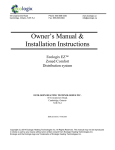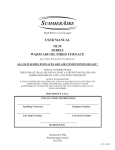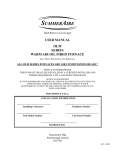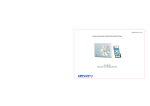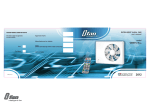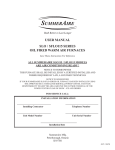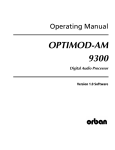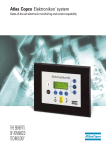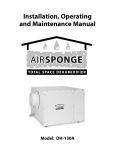Download Installation Information
Transcript
Build Better To Last Longer Residential Central Heat Recovery Ventilator User Manual Superventor Series Model SHRV 100T/SHRV124T TOP CONNECT Installation Information Installing Contractor Telephone Number Unit Model Number Unit Serial Number Installation Date Summeraire Mfg. Peterborough, Ontario, Canada, K9J 6X6 INTRODUCTION This Manual provides you with an introduction to the principles of Heat Recovery Ventilators (HRV), the operation and maintenance of your unit, guidelines to troubleshooting minor problems as they may occur and an outline of your warranty. Each of these areas are described fully under their specific headings as set out in the Table Of Contents. To obtain information relating to the installation, technical specifications and exploded parts diagram for your unit, please refer to the Installation Manual. We congratulate you on your purchase of a Summeraire unit and thank-you for choosing SUMMERAIRE. We are confident that your Summeraire HRV will provide many years of fresh air comfort to your family. Table of Contents 1. Description of Your Unit and its Benefits......................................................... 3 2. Suggested Operating Instructions..................................................................... 4 3. How to Operate Unit and Related Controls...................................................... 6 4. Optional Controls.............................................................................................. 9 5. Basic Components of your HRV..................................................................... 14 6. Maintenance.................................................................................................... 16 7. Troubleshooting.............................................................................................. 19 8. Warranty.......................................................................................................... 21 1. DESCRIPTION OF YOUR UNIT and IT’S BENEFITS Since the energy crisis in the early 1970’s, governments and the building community have sponsored many programs and changed codes to foster reduced energy requirements and create energy costs savings for the consumers. Each of these efforts, while improving the energy efficiency of our homes and buildings, has resulted in the loss of natural ventilation and trapped excess humidity and pollutants indoors. It is due to this air tightness that your dwelling or place of business will incur humidity from everyday activities such as cooking, bathing, washing, indoor drying of clothes and normal breathing and perspiration. Pollutants such as smoke from cooking and fireplaces or wood burning stoves, dust, pollens, airborne viruses and molds and radon gas can also be trapped in your residence. Your SUMMERAIRE Heat Recovery Ventilator (HRV) is designed to resolve these problems by providing fresh air into your home or building while exhausting an equal amount of stale, humid air. This “exchange” process enables you to remove undesirable pollutants continuously as well as excess humidity during the heating season. The advantage offered by your HRV is that it transfers the energy from your exhausted (inside conditioned air) to temper the incoming fresh air system. 3 2. SUGGESTED OPERATING INSTRUCTIONS Anytime the HRV is powered on allow 20 seconds for the main control to reset prior to making any operational selections. Heating Season Turn HRV ON, fan speed will cycle to previously select mode of operation. Continuous low speed ventilation is recommended to ensure that fresh air is available to building occupants. If your home feels too humid or if you have water condensation on the windows, rotate the built-in dehumidistat Dial (left side of HRV). Set dehumidistat control between 30-40% humidity. If your home feels to dry: rotate dehumidistat Dial (left side of HRV) slowly in a COUNTER-CLOCKWISE direction in 5 point increments and allow HRV to run in this position for 24 hours. If symptom continues, repeat this step. Also, if there is a humidifier installed, check to make sure it is working properly. If a higher rate of continuous ventilation is desired: Press the SELECT button (located at left hand side of HRV) once to change to the next run speed. If HRV continuous ventilation is not desired (not recommended), press the SELECT button until LED at AUTO/OFF is illuminated. HRV will not run unless a wall control is activated. Remote Touch Pad will activate 20/40/60 minutes of high-speed ventilation and then the HRV will return to AUTO/OFF. Dehumidistat activation results in high-speed ventilation until humidity level of indoor air is less than the dehumidistat setting, then the HRV will then return to AUTO/OFF. Note: If your house is too dry, it’s best to install a humidifier rather than to turn the HRV off. 4 Air Conditioning Season Continuous ventilation is recommended when the house is being heated or cooled, anytime windows are closed. For summertime operation of the HRV, turn the dehumidistat setting counter clockwise to off (80%), set run speed to LOW. Changing the stale indoor air with fresh outdoor air is just as important in the cooling season as it is in the heating season! If no HRV ventilation is desired (not recommended): Press SELECT button until LED at AUTO/OFF is illuminated. HRV will not run unless a Remote Touch Pad is activated. Wall control activation results in 20/40/60 minutes of high-speed ventilation. After 20/40/60 cycle the HRV will return to AUTO/OFF. Continuous low speed HRV ventilation is recommended throughout the year. REMOTE CONTROL DEVICES SCOUT (Remotely Located) Fan speed selection, Auto/Off and system Off maybe selected. The HRV defrost cycle is also displayed when active. 20/40/60 minute Touch Pad; Touch Pads switch the HRV to high speed for 20/40 or 60 minutes. Each touch pad station will illuminate while the HRV is running at high speed. Remote wall dehumidistat; When using a remote wall dehumidistat, set the HRV built-in dehumidistat to OFF. Adjust humidity level from the wall dehumidistat only. WATCHMAN and SENTINEL wall controls; When using these wall controls, set the HRV built-in dehumidistat to off. Operate the HRV as outlined above, but from the wall controls. Refer to specific control operation guides in this manual for further information. 5 3. HOW TO OPERATE UNIT and RELATED CONTROLS Anytime the HRV is powered on allow 20 seconds for the main control to reset prior to making any operational selections. To realize the full benefit of your HRV, it should be operated continuously to control humidity and supply fresh outdoor air. Continuous ventilation of your home is very important, and as the need arises to introduce higher levels of ventilation, you can select increased fan speeds at the HRV, or if installed, at remote devices such as; TOUCH PAD TIMERS, or SCOUT, WATCHMAN or SENTINEL controls. This section reviews the basic operation of your HRV and related controls to maximize your home comfort. All units are equipped with a Safety door switch, built in On/Off switch, Variable Speed Fan control, Dehumidistat control and have automatic damper defrost control, which is preset at the factory. 1 2 3 4 1 - Internal Dehumidistat 2 - Power On/Off Switch 3 - Option Select Button and Status Display Panel 4 - Summer / Winter Switch 6 On/Off Switch The ON/OFF switch supplies and disconnects power to the HRV control board. When positioned in the ON position, this switch will illuminate. The switch will not illuminate if the power supply is disconnected or the switch is turned to the OFF position. Option Select Button By depressing the SELECT button momentarily, you can select low, medium or high ventilation fan speeds, as well as the AUTO/OFF or SYSTEM OFF modes. The selection will be indicated by the illumination of the respective LED on the HRV display panel. Auto/Off When this mode of operation is selected, the HRV ventilator fan will be turned off until activated by the internal dehumidistat or an optional external control such as a Wall Mount Dehumidistat, Wall Switch, Touch Pad Timer, Scout, Watchman or Sentinel control. This selection is displayed by the continuous illumination of the Auto/Off LED on the HRV, SCOUT, WATCHMAN and SENTINEL controls. When the fan is activated automatically or manually at a Touch Pad, it will be indicated by the flashing On and Off of the High-speed indicator on the control panels. High Speed Flashing When the internal dehumidistat or an external control has activated the HRV to high speed, the High Speed LED light will illuminate and flash. If you have already selected one of the ventilation speeds as discussed in the previous section “Option Select Button”, and the High Speed has been activated, then you will see both the continuously lit LED for the fan speed selection and the high speed LED flashing. Once the device initiating the high speed cycle has been satisfied, the HRV control fan will reset to the pre-selected mode and the flashing High Speed LED will turn off. Summer / Winter Switch This switch must be positioned in the summer position when the optional summer core is installed in the HRV. This will cause the HRV to shut down should the air temperature entering the HRV fall below -15°C (5°F). This prevents permanent damage to the core. Position this switch to winter when the winter core is used to ensure correct operation during colder periods. 7 Status Display Indicator Lights The LED indicator lights illuminate to indicate the current active mode of operation. The defrost indicator will illuminate when the HRV cycles into the automatic defrost cycle; this occurs at a predetermined cycle time whenever the outside air stream entering the HRV is colder than -3°C (26°F). Defrost Cycle Your HRV is equipped with electronically controlled damper defrost. When the outdoor temperature entering the HRV drops below -3°C (26°F) the defrost timer is activated. After approximately 30 minutes of ventilation (during which time the core unit may experience some frost build-up during the heat recovery process) the timer activates the damper door mechanism which closes off the fresh air supply port, opens the defrost port and the defrost led illuminates. After approximately 5 minutes of defrosting the recovery core, the damper door reverses direction and reopens the fresh air port and the unit returns to normal operation and the defrost led turns off. The cycle will repeat itself until the outdoor temperature entering the HRV rises above -3°C (26°F). Internal Dehumidistat This control regulates the desired amount of humidity in your home during the heating season. By simply adjusting the rotary knob on the HRV, varied levels of relative humidity can be selected.During the colder months of winter, the Internal Dehumidistat should be set to an industry recommended comfort range of 30% to 40% relative humidity (R.H.). If the house feels too dry, then adjust the setting higher and if too damp, then adjust the setting lower.During these colder months, the Internal Dehumidistat should be set lower if excessive moisture develops on the windows. In the warmer months, when the outdoor humidity is equal to or greater than the indoor humidity, the dehumidistat should be turned to the OFF position. 8 OPTIONAL CONTROLS 20 Minute Remote Timer Touch Pad Model ECPBT This 20-Minute Touch Pad MUST be connected to the “CT” terminals on the HRV exterior. This control will not function if connected PBT connection points. Install using 18/2-thermostat wire. Maximum number of ECPBT controls per HRV is eight. Maximum cumulative lead length is 2000 lineal feet. Touch pads are typically installed where 20 minutes of high speed ventilation may be desired. Once activated by a momentary push, approximately three seconds, of the SELECT button on the Touch Pad the HRV is switched to high speed ventilation and the Touch Pad LED will illuminate. The HRV will reset to the previously selected mode of operation once the 20 minutes have expired. To cancel the selection, depress the SELECT button on the 20-minute Touch Pad for a minimum of 3 seconds. The selection can also be cancelled at any other optional control by momentarily depressing the SELECT button. NOTE: This control will not respond while a crank timer is operational. 9 Remote Timer Touch Pad - Model PBT Timer Touch Pads are typically installed in any room where 20/40 or 60 minutes of high-speed ventilation may be desired, i.e. bathrooms and/or kitchens. Once activated by a momentary push, these buttons illuminate to indicate high speed activation. If more than one touch pad is installed in the system then all will illuminate upon activation until the timed sequence has expired. To cancel a selection simply continue to push the select button until it turns off. The display LEDS on the touch pad will illuminate to represent the time remaining. Wall Mount Dehumidistat - Model SRDEH This control is typically installed in an area of the home where humidity may require automatic monitoring. This could be a central location (i.e. near furnace thermostat) or in a specific room (i.e. kitchen, laundry etc.). Scout Control This control is detachable from the HRV to provide a remote control operation of the HRV. Once removed from the HRV one can only turn the power off at the HRV. By positioning the Scout remotely to the HRV, you can adjust fans speeds, select auto/off, intermittent or turn the main HRV control Off. When the HRV has been turned off using the Scout, power still remains on at the HRV on/off switch however all external controls will not function. Intermittent- In this mode the ventilation fan will run for 20 minutes and turns off for 40 minutes. This cycle will continue until cancelled. External devices are active. 10 WATCHMAN CONTROL The WATCHMAN is an intermediate remote control. It permits the following function selections; SYSTEM OFF- In this position all internal and external controls are disabled. Power remains on at the HRV. FAN SPEED- Low Medium or HIGH can be selected. INTERMITTENT- In this mode the ventilation fan will run for 40 minutes and turns off for 20 minutes. This cycle will continue until cancelled. External devices are active. AUTO/OFF-In this mode the ventilation fan remains off until activated by either the internal dehumidistat or an external control such as a Touch Pad or Dehumidistat. During the off mode the cold air port in the HRV is closed. RELATIVE HUMIDITY- By rotating the control dial you can select desired levels of indoor humidity. Humidity reduction will only occur during the heating season. Should the set point be below the indoor relative humidity the HRV will automatically switch to high speed (provided that the active mode selected permits the remote device to be active). SENTINEL CONTROL The SENTINEL control is the deluxe control using a digital LCD display to indicate HRV status. The top line of the display indicates the current mode of operation, the lower left side indicates the ventilation fan status and the lower right hand side indicates the current relative humidity.The following option selections are available in addition to those offered by the WATCHMAN; TIMED HIGH SPEED- 20/40 or 60 minutes of high speed ventilation can be selected or cancelled. FILTRATION- In this mode the HRV fan runs continuously recirculating indoor air through the 11 HRV filters. During this cycle the outdoor cold air port is closed. No fresh air is introduced. CLEAN FILTER INDICATOR- Twice annually the control will display on the LCD the need to clean the filters and core. Refer to the maintenance for the method advised. To make a selection, depress the left button identified as SELECT/SET. As you push this button you will see the display change to the various operating options ie. VENTILATION, SET FAN TIMER, SET FAN SPEED, SET HUMIDITY etc.. Once you have selected the desired option, press the CHANGE button on the right to make a change, then press the SELECT/SET button on the left to save and initiate the selection. To confirm that the selection was made, the display will momentarily read “SET UP CHANGED”, it will then default to the selected mode of operation. Note that fan speed must be selected prior to selecting the FILTRATION mode. Failure to select the fan speed first will result in the fan defaulting to the previous mode of operation during the FILTRATION cycle. SCOUT / WATCHMAN Indications MODE SCOUT WATCHMAN Intermittent Fan Off Auto Off, Blink Intermittent LED ON, Blink Auto Off Intermittent Fan Hi High, Blink Intermittent LED ON. Blink Hi Filtration Default fan speed, Slow Blink Default fan speed, Slow Blink Summer Switch on Temp <5deg°F System Off, Blink System Off, Blink Filtered Air Out Air In Filtration 12 OPTIONAL SUMMER CORE DEFROST SCHEDULE When using the summer core, the Summer/Winter switch at the left hand side of the HRV must be set to summer. When the summer switch is ON the following defrost schedule is followed for temperatures below -5.5°C (22°F) and below -15°C (5°F) . While the temperature is above -5.5°C (22°F) the system operates normally. While the temperature is below -5.5°C (22°F) and above -15°C (5°F) , the system will run a defrost cycle (fan high) for 6 minutes. At the end of the defrost period the system will return to the previously selected mode. After 32 minutes, if the temperature is below -5.5°C (22°F) but above -15°C (5°F), this defrost cycle will be repeated. If the temperature is below -15°C (5°F) , the system will run the 6 minutes defrost period and then switch to fans off. After 54 minutes, if the temperature is below -15°C (5°F) , the 6 minute/54 minute schedule will be repeated. If the temperature remains below -15°C (5°F) for four cycles of 6-54 the system go to the System Off mode. The system Off LEDs will blink and the will display INSTALL WINTER CORE. If the temperature remains above -15°C (5°F) for more than an hour, the cycle count will be reset to zero. This permits the system to continue to operate if the temperature is only below -15°C (5°F) for less than four hours. NOTE THAT THE SUMMER CORE WILL BE PERMANENTLY DAMAGED SHOULD IT BE EXPOSED TO TEMPERATURES BELOW ---- 15°C (5°F) . When the summer core is installed in the HRV the select switch on the left hand side must be set to summer. Failure to do so will result in permanent core damage. When using the winter core, this select switch must be set to winter to ensure proper HRV operation during the colder periods. 13 4. BASIC COMPONENTS OF YOUR HRV 3 4 5 6 2 1 17 16 15 14 7 13 8 12 9 11 10 1 - ON/OFF Switch 2 - Dehumidistat 3 - Door Safty Switch 4 - Air Filter 5 - Heat Recovery Core 6 - Door Hinge 7 - Damper Motor 13 - Supply Fan Panel Access 8 - Damper Door Screw (8) 9 - Exhuat Fan 14 - Summer/Winter Switch 10 - Door Latch 15 - Terminal Block 11 - Door Latch 16 - Option Select Switch 12 - Condensate Tray 17 - Status Display Do not attempt to operate damper door manually. To do so will result in damper motor failure. Heat Recovery Core (winter core) One of the most important components of your HRV is it’s Heat Recovery Core. In the winter months, during the heating season, this plated Core recovers energy from the stale humid air being exhausted and transfers this energy to temper the incoming colder fresh air. This process also reduces indoor relative humidity during this time. In the summer months, during the air conditioning season, the incoming fresh air is conditioned as it passes through the Core. This occurs as the conditioned indoor air being exhausted cools the Core and the incoming fresh air. The Winter Core is designed of an impenetrable polymer material so that the 14 air streams remain separate (no cross-contamination) thereby ensuring that the fresh air is not exposed to the potential contaminants and humidity in the exhausted air stream. Energy Recovery Core (summer core) The Summer Core not only conditions the incoming air but also transfers moisture contained in the incoming fresh air to the exhausting stale air. This benefit reduces the cooling load on the air conditioning system. Safety Door Switch The HRV safety switch is activated when the main front door is fully closed. When the front access door is opened electrical power is disconnected to the HRV main control board disabling all functions of the HRV. Internal Dehumidistat Indoor relative humidity (RH) is monitored continuously by the internal dehumidistat during fan on cycles. By rotating the dial on the front of the HRV you can select the desired level of indoor humidity. Range of operation is approximately 20% to 80%. Should the level of RH exceed the level selected then the HRV will automatically switch to high speed until the indoor RH drops below the level selected. The HRV fan must be on for the dehumidistat to function correctly. Note that during the summer months when the outdoor humidity may be at elevated levels, all dehumidistats must be turned to the off position to prevent the HRV from running on high speed continuously. Indoor humidity will only be reduced when outdoor relative humidity is lower ie. during the heating season. Damper Door This damper door is operated automatically by the main HRV control should the outdoor air temperature entering the HRV fall below 26°F (-3°C). When activated, this damper closes off the stale exhaust port within the HRV and opens the internal defrost port. The defrost cycle is approximately 5 minutes in duration, followed by a ventilation cycle of approximately 30 minutes. This cycle repeats until the outdoor air temperature entering the HRV rises above -3°C (26°F). During the defrost cycle it is not unusual to see water condensate dripping through the drain lines. Do not attempt to reposition this damper, as permanent damage to the damper motor will result. 15 5. MAINTENANCE In addition to the maintenance procedure outlined below, we recommend that you inspect the exterior hoods on your unit every month. This is to ensure that your exhaust and fresh air supply ports are not restricted by debris (i.e. cottonwood, leaves, grass, snow or frost (ice) buildup on the mesh cover(s). Restriction of these ports will cause the unit to work inefficiently and malfunction. Caution: Unplug the unit prior to performing maintenance or working inside the unit. Please do not attempt to reposition the damper door as this will cause permanent damage to the motor. Every Six Months Disconnect the power supply 1. Unlatch the door latches at the bottom of the front door panel and gently raise the door to a level position while securely holding the door panel in place (apply pressure to the right) (CAUTION - Door can slip off hinges). Once open, hold the access door securely and slide it to the right. This will disengage the upper hinges allowing the door to be removed. 2. Remove the filters as shown and wash in warm, soapy water, rinse, let dry and replace. 3. Remove the HRV Winter Core by sliding it out evenly along the channel tracks, wash in warm soapy water, rinse, let dry and replace. To replace properly, slide the core back into the tracks with the label attached to the core indicating the top upright position of the Core, in the most top upright location. Caution: Do not expose the Summer Core to water. To do so will result in permanent damage. Simply vacuum the surfaces of the summer core lightly with a brush attachment. We suggest that you wear gloves when handling the Cores as some edges may be sharp. 4. Clean and inspect the condensate trays by wiping with a damp cloth. Observe the tray outlets and the drain hose to ensure they are clear of debris. If debris is present flush out the drain system with warm soapy water or have the hose replaced. 16 Every Three Years - Clean Fan Blades Fan blades can accumulate dust and dirt creating reduced airflow and potential imbalance of the blades. It is also our recommendation that you consider having a qualified service contractor perform your Fan Blade maintenance. Fan Maintenance 3 2 Fig.1 1 CAUTION: Internal HRV components can have sharp metal edges Recommend wearing gloves. 17 Refer to Fig.1 Page 17 1. As described in the prior section, unplug unit and open access door (swings up). 2. Remove dehumidistat knob (3) by gently pulling it forward. 3. Remove wire leads from terminal strip by loosening securing screws in front of terminal strip. Be sure to identify leads and location prior to removing to ensure they are returned to the correct location. 4. Remove front cover securing screws (1) and front cover (2). 5. Using a small brush (i.e. toothbrush), clean the wheel blades. Caution must be exercised not to disturb the balancing weights on the wheel blades. 6. Reassemble. 7. Reconnect the power supply to the fan motor. 18 6. TROUBLE SHOOTING Control Functions Symptom Possible Cause Possible Solution Nothing works Front access door safety switch Ensure that HRV is plugged in Front access door safety switch Unlatch door, inspect safety switch Lack of power. Defective component Ensure that outlet in use is powered Contact your installer HRV front panel On/Off switch illuminates but fan is not running Mode of operation selected set to “Auto Off” Select a different operation mode at HRV or remote device HRV status panel flashing HIGH Continuously HRV internal dehumidistat set too low. Adjust dehumidistat RH setting to a higher setting. Remote push button activated. Check to see if a push button has been activated. Defective component. External dehumidistat set too low. Defective dehumidistat. Contact your installer Adjust external dehumidistat set point higher. Contact your installer. Defective PC board. Contact your installer. Operational Functions Symptom Possible Cause Possible Solution HRV is operating but little or no air flow is present. Air stream blockage Check outside weather hoods for blockages such as snow, grass, insects, cottonwood. Dirty air filters or heat exchanger Core. Inspect and clean air filters and core. Heat exchanger core frozen solid. Defective component. Open HRV access door and defrost Core. Contact your installer. Have unit inspected for defective sensors, check system balancing. Contact your installer. 19 Control Functions Symptom Possible Cause Possible Solution Poor air quality excess moisture on windows. HRV turned off Adjust ventilation rate higher and HRV running on too low a speed monitor conditions overnight. Adjust further if necessary. If HRV is connected to furnace ductwork (both exhaust and supply) Temporary conditions causing effect. Ensure that furnace is turned on to circulate air. Activate to high speed at push button or Airmonitor. Indoor air temperature too low. Keep temperature above 18°C (64°F) Excessive humidity conditions within home. Turn down internal or remote dehumidistat. Consider source such as improper foundation drainage, moisture intrusion into exterior walls, moisture generation, excessive moisture conditions. New wet construction. Indoor air considered too dry HRV speed selection too high for conditions. Set to a lower speed. Check dehumidistat settings. Adjust higher. Set to intermittent mode of operation. Temporarily use a humidifier. Excessive frost build up on ducts connected to HRV. Supply air too cold. Extreme outdoor air temperatures. Operate HRV on intermittent. Operate HRV at a lower ventilation rate. Have a duct heater installed. Imbalance in air flow streams. Defective defrost system. Defective Vapor Barrier. 20 Have the system’s balancing checked. Have the defrost system checked. Inspect duct connections at collars, look for vapor tear and repair. 7. WARRANTY HRV Unit Summeraire Mfg. warrants the entire Heat Recovery Ventilator to the original purchaser should it prove to be defective by reason of defective material and or faulty workmanship with in two (2) years of the purchase date. Extended warranties are offered for the “Core” and “Electrical components” as outlined below. Core Summeraire Mfg. warrants the “Core” of the Heat Recovery Ventilator to the original purchaser if the core has become defective by reason of defective material and/or faulty workmanship. This warranty applies to the original purchaser of the Heat Recovery Ventilator for as long as they own the dwelling. Electrical Components Summeraire Mfg. warrants the “Electrical components” of the Heat Recovery Ventilator to the original purchaser if any of the electrical components have become faulty by reason of defective material and/or faulty workmanship. This warranty applies to the original purchaser of the Heat Recovery Ventilator for a period of five (5) years from the date of purchase as long as they own the dwelling. 21 General Provisions Summeraire Mfg. will supply a replacement HRV unit or component as prescribed in the forgoing section, F.O.B. Peterborough, Ontario, Canada. Replacement units and/ or components are warranted for the remainder of the original warranty period. This warranty does not cover defects caused by: modifications, alteration, abuse to, or misuse of the product or it’s operation in a manner contrary to the instructions included with the unit at the time of shipment, or failure to perform maintenance as detailed in aforementioned instructions. This warranty expressly supersedes all other warranties and obligations of Summeraire Mfg.. No person has authority to alter or modify the terms of this warranty in any matter. This warranty does not include any freight, labour, including diagnostic labour, or sales tax that might be incurred by the purchaser if a unit and or parts require replacement. Under no circumstances shall Summeraire Mfg. be liable to the purchaser or any other person(s) for any consequential damages, whether arising out of breach of warranty, breach of contract, negligence or otherwise. Keep your warranty at work for you. Please complete and mail your Warranty Registration Card to Summeraire Mfg., 2040 Fisher Drive, Peterborough, Ontario, Canada, K9J 6X6 to register this warranty. 22 Notes: 23 Summeraire Mfg. 2040 Fisher Drive, Peterborough, Ontario Canada, K9J 6X6 X-100T-124T-USMAN-EN-REV2



























